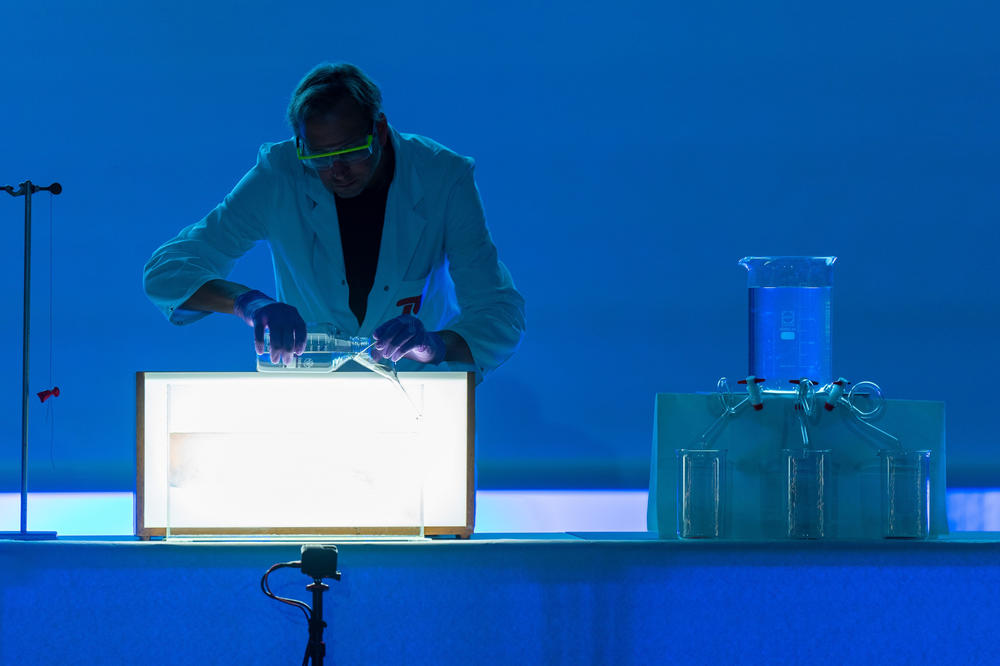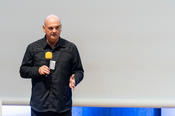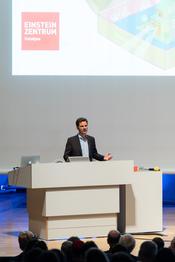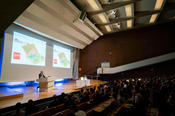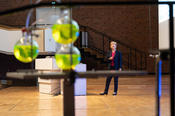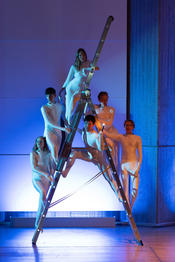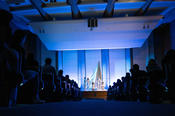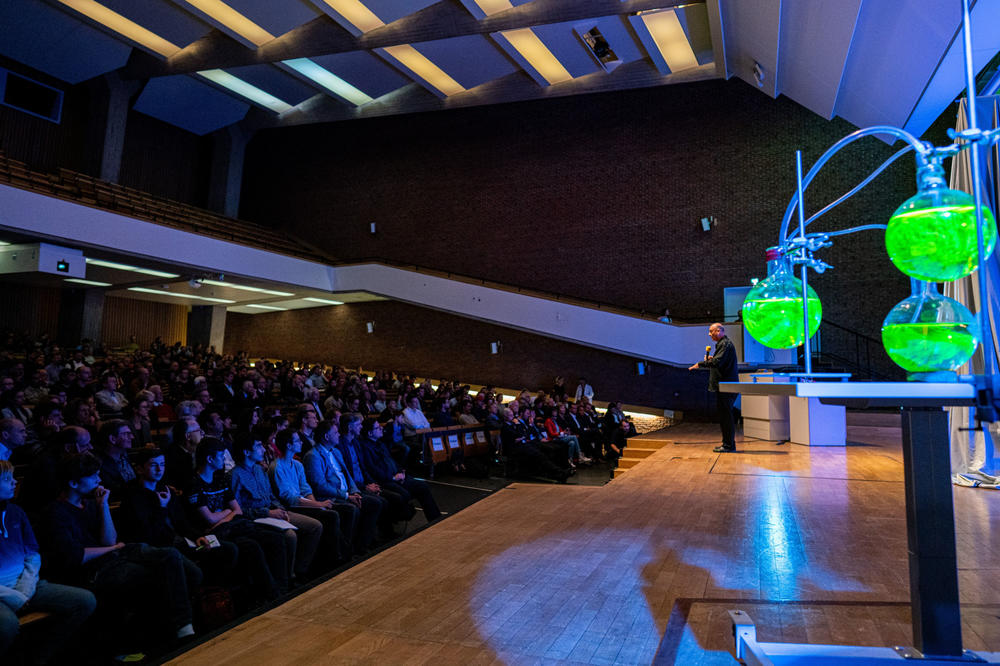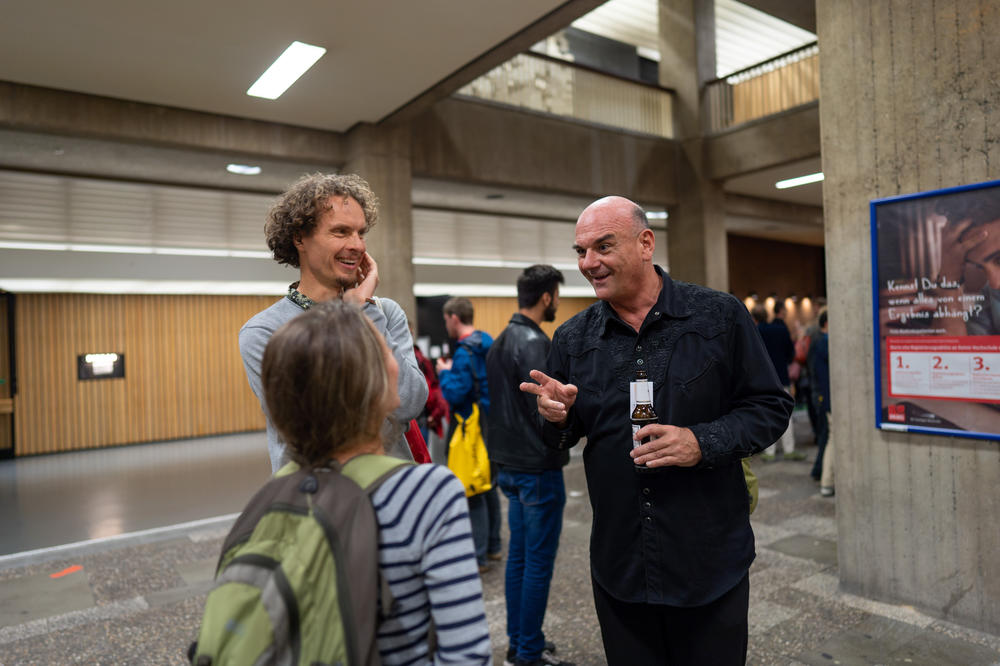Moving toward Green Chemistry
Technische Universität Berlin officially opened Berlin’s only scientific Cluster, UniSysCat, with music, dance, and impressive experiments
Oct 15, 2019
Fascination catalysis: Stefan Schutte, a technical assistant at the Institute of Chemistry at Technische Universität Berlin, presented two chemical reactions at the opening ceremony of the Cluster of Excellence.
Image Credit: Dominic Simon
It is clear from the start, with the piece of music that can be heard through the packed main lecture hall of Technische Universität Berlin, that something big is being created here. For Matthias Drieß, Benjamin Britten’s “A Young Person’s Guide to the Opera” – in which all the orchestral instruments first play individually and then come together to form an impressive whole – is the quintessence of science. “In the orchestra, everyone plays together, but everyone has their own instrument,” said the professor of chemistry at Technische Universität Berlin and one of the three spokespersons for the UniSysCat Cluster of Excellence. As presenter, Drieß led the audience through the opening ceremony. “For this to work, you need good communication,” said Drieß, something that UniSysCat also relies on. It is about catalysis, and about accelerating chemical and biological processes with as little activation energy as possible.
“Over the past ten years, we have learned to speak a common language as biologists and chemists,” said Arne Thomas – also a chemistry professor at Technische Universität Berlin and a UniSysCat spokesperson – in his keynote speech. “Now we have set out not only to optimize catalysis research, but to revolutionize it,” said Thomas, adding that being allowed to say this as a basic researcher is a “luxury” and the motivation is green chemistry. “Chemical processes must become more energy-efficient,” Thomas explained to the audience. “For this it is incredibly important to continue research into catalysis.”
“The research taking place here is of great interest to people all over the world.” Christian Thomsen
Christian Thomsen, the president of Technische Universität Berlin, praised this new – green – research aspect in his welcoming speech. “The Fridays for Future climate demonstrations have fired it up again. The research taking place here is of great interest to people all over the world,” said Thomsen. The Berlin International Graduate School of Natural Sciences and Engineering (BIG-NSE), which belongs to the Cluster, thereby forms an important interface. “Graduates carry the idea of green chemistry into their further careers.”
UniSysCat is also supported by the Senate Chancellery for Higher Education and Research, as State Secretary Steffen Krach emphasized. “I am really glad this Cluster was successful. It is incredibly impressive how the scientists from Berlin have worked on making this Cluster of Excellence possible,” he said.
Catalysis research is regarded as a key driver for “green chemistry,” which focuses on sustainability and resource conservation.
Image Credit: Dominic Simon
Cynthia Friend, an award-winning chemist and professor who has worked at Harvard University since 1982, explained what is already possible. She is trying to produce stable catalysts lasting decades; her goal is the long-term chemical storage of energy. During the development of the Cluster, Friend worked as a consultant in close cooperation with the UniSysCat team and hopes to continue working with the Berlin team in the future. “Traditional boundaries between the natural sciences are being torn down here,” Friend said later at the champagne reception. Friend sees this as novel and extremely impressive. “To go through this process will be worth the trouble. I am curious to see what UniSysCat will produce.”
Stefan Schutte showed how fascinating catalytic processes can be today. The technical employee at the Institute for Chemistry at Technische Universität Berlin presented two reactions in the main lecture hall, as the lights were dimmed and classical music was turned up. In the Briggs-Rauscher reaction, the oscillating iodine clock, hydrogen peroxide decomposes to oxygen and water when starch is added. In an aquarium-like showcase, bubbling blue waves billowed up and down, swirled and disappeared, only to rebuild into blue waves out of nowhere in the next moment. In another experiment, iron as a catalyst in a mixture of luminol and hydrogen peroxide produced fluorescent colors – the shimmering blue initial liquid flowed through three valves and became neon yellow, pink and green in the collecting containers.
“Science, especially chemistry, is just that: passion and courage to question things.” Matthias Drieß
As another show interlude, six drama students from Berlin University of the Arts staged a dance performance. Directed by Giorgi Jamburia, a student of dramatic writing, they walked onto the stage in white full-body costumes and lifted the veil from a huge ladder. Only one of the six dared to climb the ladder with a burning candle. Later the others also made the attempt, but each one ultimately failed. Only together could they finally succeed in bringing the candle up the ladder.
Good atmosphere after the opening ceremony: Juri Rappsilber from the Bioanalytics Department of Technische Universität Berlin and Matthias Drieß.
Image Credit: Dominic Simon
Later while having a drink in the foyer, Matthias Drieß said he was very moved by the piece. “Science, especially chemistry, is just that: passion and courage to question things,” says Drieß. “It is about lifting the veil and figuring out what is behind it.” This is exactly what UniSysCat intends to do in the next seven years. And in the end, the individual research groups will hopefully have taken catalysis to a new level – together, like the instruments of an orchestra.

